How To Format A Usb Drive On Windows 10
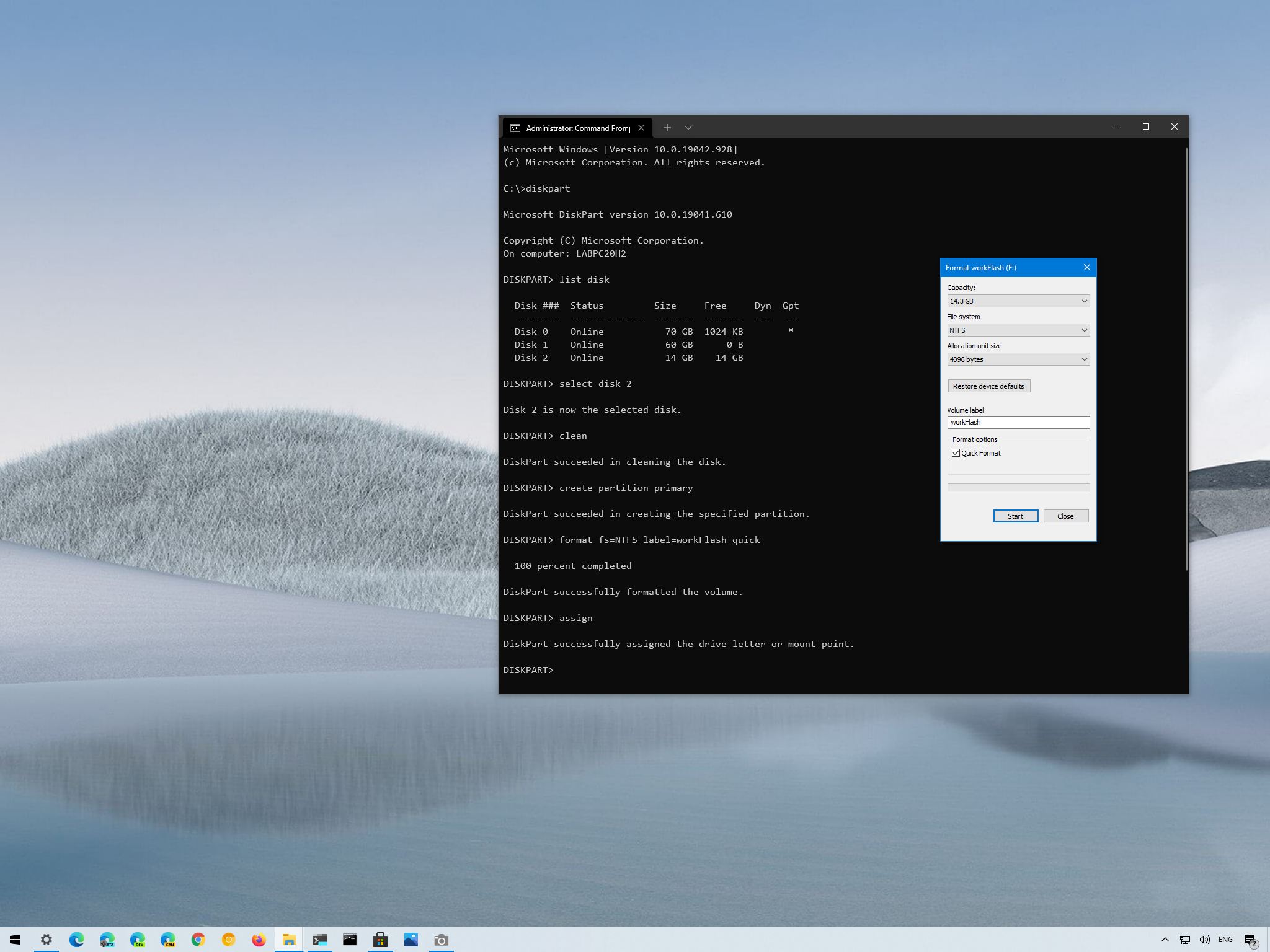 Source: Windows Central
Source: Windows Central
On Windows 10, the ability to format a USB flash drive can be helpful in many scenarios. For example, sometimes, you may need to reformat a removable storage device to make certain it does non contain whatever malicious code or when the thumb drive is not accessible because of information corruption. Y'all received a flash bulldoze using a file organisation that happens to be incompatible with your system configuration. Or yous programme to go rid of the storage device and want to make sure you are non leaving behind any personal information.
Regardless of the reason, Windows 10 includes several tools to format all kinds of storage (such as USB flash drives) using File Explorer, Deejay Management, Control Prompt, and PowerShell.
In this Windows 10 guide, we volition walk you lot through the different ways you tin can format a USB wink drive to quickly erase its contents or fix problems when the device isn't recognized.
Alert: The instructions outlined in this guide volition erase everything on the selected drive. If you accept any important files, you should back them upward before proceeding.
How to format USB flash drive with File Explorer
To format a USB flash drive using File Explorer on Windows ten, use these steps:
- Open File Explorer.
- Click on This PC from the left pane.
-
Under the "Devices and drives" department, right-click the flash drive and select the Format option.
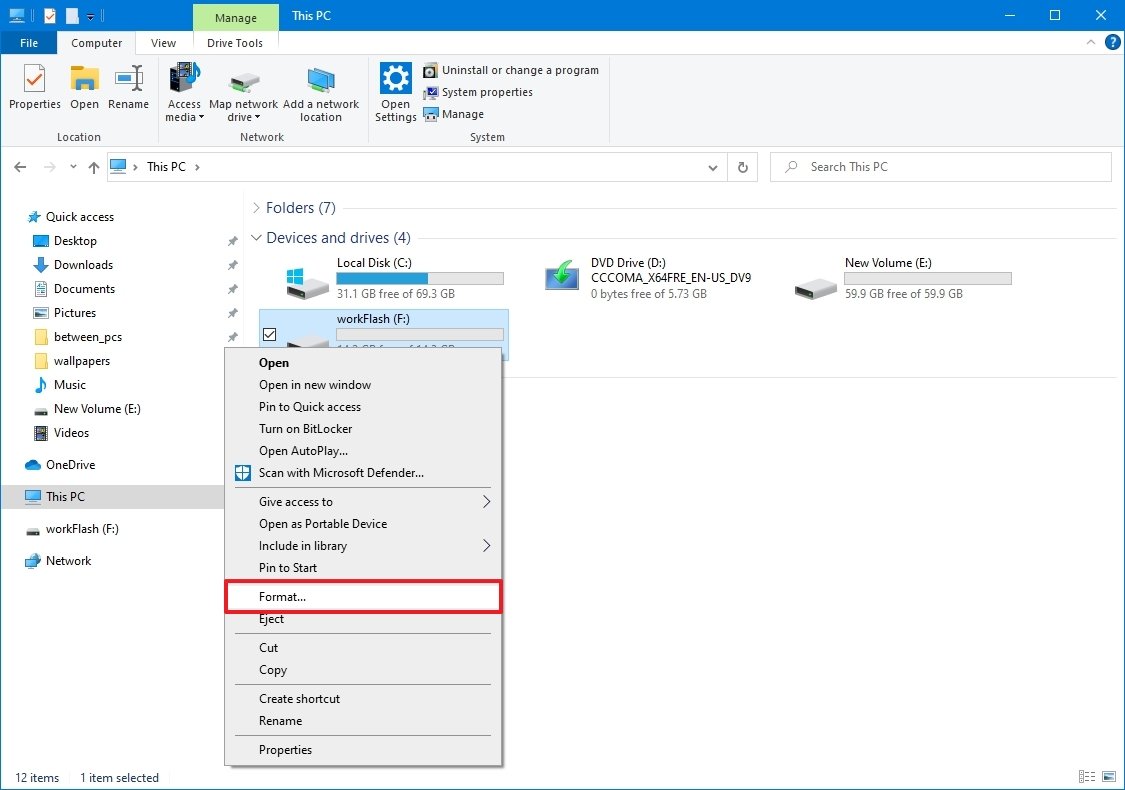 Source: Windows Central
Source: Windows Central -
Apply the "File system" drib-down carte and select the NTFS option.
Quick tip: If you plan to employ the removable storage on Windows 10 as well as on macOS systems, yous may desire to select the exFAT option for compatibility. Nevertheless, if you think nigh using the device on a Linux auto, FAT32 is the best option, fifty-fifty though you will be limited to 4GB file sizes.
- In the "Allocation unit size" drop-down carte, use the default selection.
- In the "Volume characterization" field, ostend a drive name that will appear in File Explorer. For example, workFlash.
-
Nether the "Format options" section, select the Quick format option.
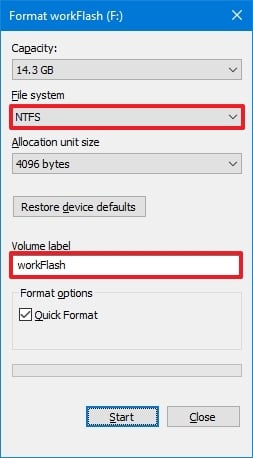 Source: Windows Fundamental
Source: Windows Fundamental Quick note: The "Quick format" option just deletes the file system table and the root folder, but the data may still be recoverable. If y'all do not check the choice, a full format functioning volition be performed, and it will do a scan for bad sectors and writes zeros in all sectors deleting the information. Equally a result, this procedure can accept a long time, depending on the size of the drive.
- Click the Start button.
- Click the Yes button.
Once y'all consummate the steps, the wink drive will be ready to store documents, pictures, videos, and other files on the removable bulldoze.
How to format USB flash drive with Disk Direction
The Disk Management tool offers at to the lowest degree two routes to format a USB flash bulldoze. You can format the storage to rebuild the file system table and erase the content, or you tin can delete the partitioning that comes in handy to prepare storage problems.
Format flash drive
To use Disk Management to format a USB bulldoze, use these steps:
- Open Get-go.
- Search for Create and format hard disk partitions and click the top consequence to open up the Deejay Management tool.
-
Correct-click the removable drive and select the Format option.
 Source: Windows Key
Source: Windows Key - In the "Volume characterization" field, confirm a proper noun to identify the storage in File Explorer.
- Use the "File system" drop-down menu and select the NTFS option. (Y'all can likewise select the "FAT32" or "exFAT" choice.)
- In the "Allocation unit size" drop-down card, employ the Default pick.
-
Cheque the Perform a quick format selection.
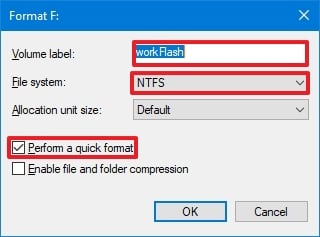 Source: Windows Cardinal
Source: Windows Cardinal - (Optional) Check the Enable file and folder compression option.
- Click the OK button.
After you complete the steps, the bulldoze will exist erased and reformatted to store data once again.
Clean and format flash drive
If you are dealing with errors or other issues, you can clean the USB drive and start over again from scratch with a new sectionalisation and file arrangement with Deejay Management.
To clean and format a USB flash drive, use these steps:
- Open Start.
- Search for Create and format difficult deejay partitions and click the meridian result to open up the Deejay Direction tool.
-
Correct-click the removable storage and select the Delete volume option.
 Source: Windows Central
Source: Windows Central - Click the Yeah button.
-
Right-click the "Unallocated" infinite and choose the New Simple Volume selection.
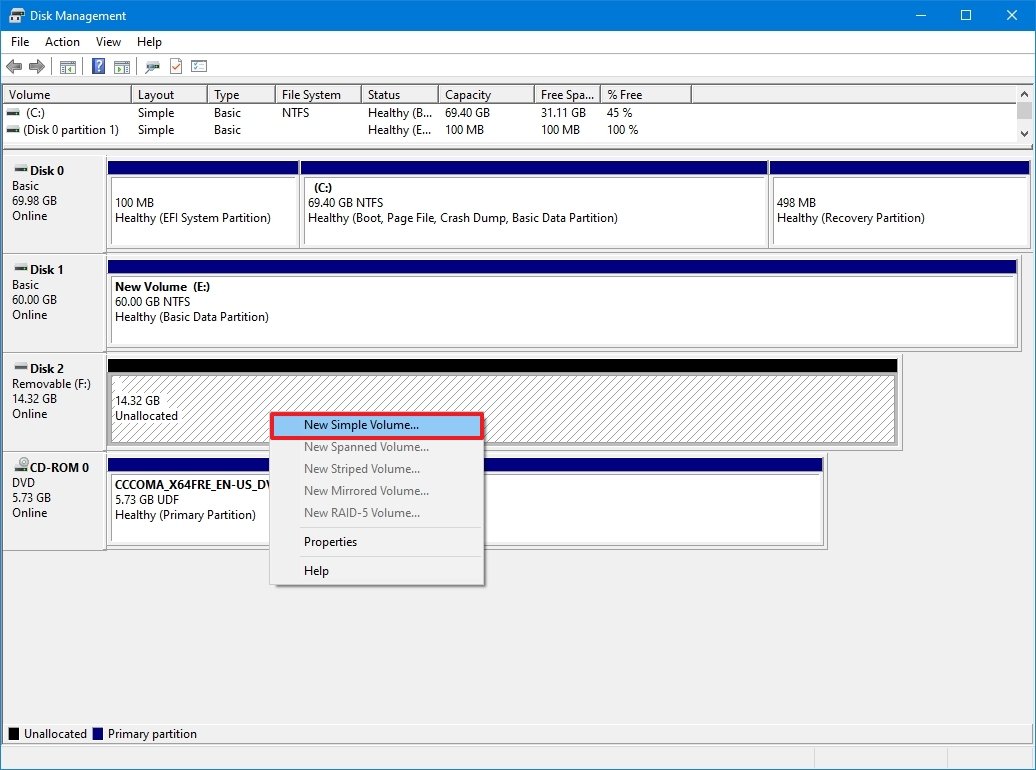 Source: Windows Central
Source: Windows Central - Click the Adjacent button.
- Click the Side by side button again to use all the available space.
- Select the Assign the following drive alphabetic character option.
-
Employ the drib-downwards menu to select one of the available letters.
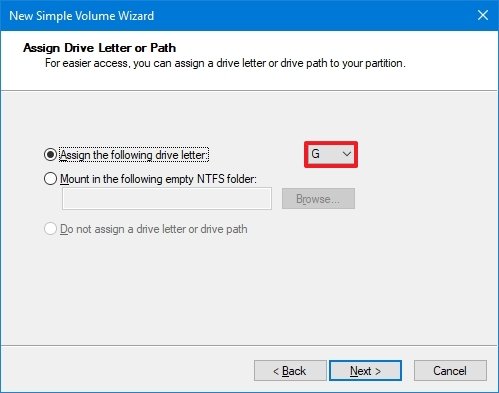 Source: Windows Cardinal
Source: Windows Cardinal Quick tip: If you assign a letter manually, it is best to select a letter in reverse order (Z, Y, Ten, and so on).
- Click the Next button.
- Select the Format this volume with the following settings option.
-
Use the File organization drop-down menu and select the NTFS option.
Quick note: Using this method, you can only use "NTFS" or "FAT32." If y'all need to format the drive using "exFAT," y'all will need to use Control Prompt or PowerShell
- In the "Allocation unit size" drop-downward carte, use the Default option.
- In the "Volume label" field, blazon a characterization to identify the flash bulldoze in File Explorer quickly.
-
Cheque the Perform a quick format option. (If you clear the selection, a full format volition take place that can accept some time depending on the storage size.)
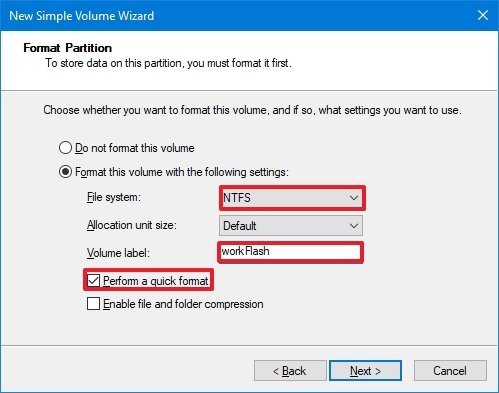 Source: Windows Fundamental
Source: Windows Fundamental - (Optional) Check the Enable file and folder compression option.
- Click the Next button.
- Click the Finish push button.
Once you complete the steps, the process will create a new partition and gear up the file system, fixing common problems with the flash drive, including data corruption.
If you cannot perform a format, the removable drive is probably broken. If this is the case, you can e'er buy another USB flash drive, such as the SanDisk Ultra Fit USB three.1 flash drive, which comes in 16GB up to 512GB variants with plenty space to save large files and small backups. You can find fifty-fifty more than great options in our roundup of best flash drives.
Reliable storage
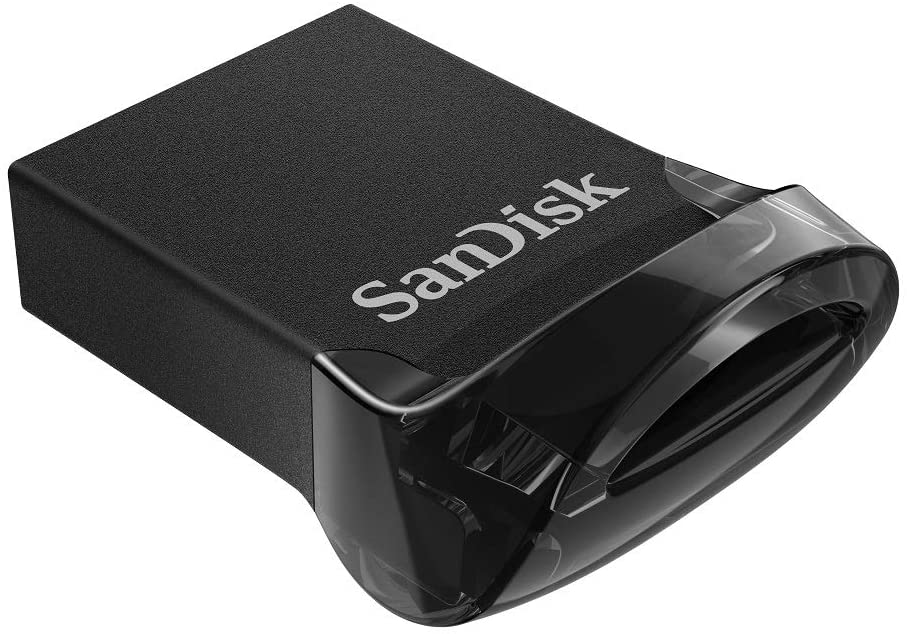
SanDisk Ultra Fit
If you're in the market for a reliable thumb drive with enough storage for large projects and fast transfer speeds, the SanDisk Ultra Fit USB 3.1 wink drive is an excellent option. The removable drive offers up to 512GB of storage with transfer speeds up to 130MB/due south, it's backed by a potent make, and it even includes some nifty features similar password protection, recovery, and encryption. It'southward also affordable, at around $6.32 for 16GB.
How to format USB flash bulldoze with PowerShell
You can fifty-fifty employ PowerShell commands to format a USB flash drive to erase its content. Or the command-line tool tin can also be used to clean and format the storage to resolve corruption and other problems.
Format flash drive using PowerShell
To format a USB flash drive using PowerShell commands, use these steps:
- Open Start.
- Search for PowerShell, right-click the top result, and select the Run as administrator pick.
-
Type the following control to perform a quick format on the flash drive and press Enter:
Format-Book -DriveLetter Bulldoze-Letter of the alphabet -FileSystem FILE-Organisation -NewFileSystemLabel Drive-NAMEIn the control, supercede DRIVE-LETTER with the correct alphabetic character reflecting the bulldoze you want to format, FILE-SYSTEM for FAT32, exFAT, or NTFS, and DRIVE-Proper name with the proper name you want the device to appear in File Explorer.
This example performs a quick format of the "F" drive with the NTFS file system:
Format-Volume -DriveLetter F -FileSystem NTFS -NewFileSystemLabel workFlash Source: Windows Primal
Source: Windows Primal -
(Optional) Blazon the following command to perform a full format of the USB flash drive and press Enter:
Format-Volume -DriveLetter Drive-Alphabetic character -FileSystem FILE-System -Full -ForceIn the command, replace Drive-Letter of the alphabet with the correct letter of the alphabet reflecting the bulldoze you want to format, and FILE-Organisation for FAT32, exFAT, or NTFS, depending on the file system y'all want to use. If you do not know, and you lot are using Windows ten, then you could use NTFS. The
Totalselection tells the command to perform a full format, and the-Forcechoice specifies the override switch.This example performs a full format of the "F" drive:
Format-Volume -DriveLetter F -FileSystem NTFS -Full -Force
After you lot consummate the steps, PowerShell volition format the removable storage with the settings you specified.
Clean and format flash drive using PowerShell
To clean and format a removable drive with PowerShell commands, use these steps:
- Open Start.
- Search for PowerShell, right-click the peak event, and select the Run as administrator option.
-
Type the following control to view the flash drive you want to fix and printing Enter:
Get-Disk -
Type the post-obit control to delete the volume and press Enter:
Get-Disk DISK-NUMBER | Clear-Disk -RemoveDataIn the command, change DISK-NUMBER for the right number representing the flash drive you are formatting.
This example selects and cleans the disk number ii:
Go-Deejay 2 | Clear-Disk -RemoveData -
Type Y to confirm the activity and press Enter.
-
Blazon the following control to create a new division and printing Enter:
New-Sectionalisation -DiskNumber Deejay-NUMBER -UseMaximumSizeIn the command, modify Disk-NUMBER to the correct number representing the storage you are formatting.
This example creates a new partition using the entire space available on drive number ii:
New-Segmentation -DiskNumber 2 -UseMaximumSize -
Type the following control to perform a quick format and assign a bulldoze label, and press Enter:
Become-Sectionalization -DiskNumber Deejay-NUMBER | Format-Book -FileSystem FILE-SYSTEM -NewFileSystemLabel DRIVE-NAMEIn the command, change Disk-NUMBER for the number that identifies the storage in the system, FILE-Organization for "NTFS," "FAT32," or "exFAT," and DRIVE-Proper name with the proper noun y'all want the device to appear in File Explorer.
This instance selects and formats drive number 2 using the NTFS file system:
Get-Partition -DiskNumber 2 | Format-Volume -FileSystem NTFS -NewFileSystemLabel workFlash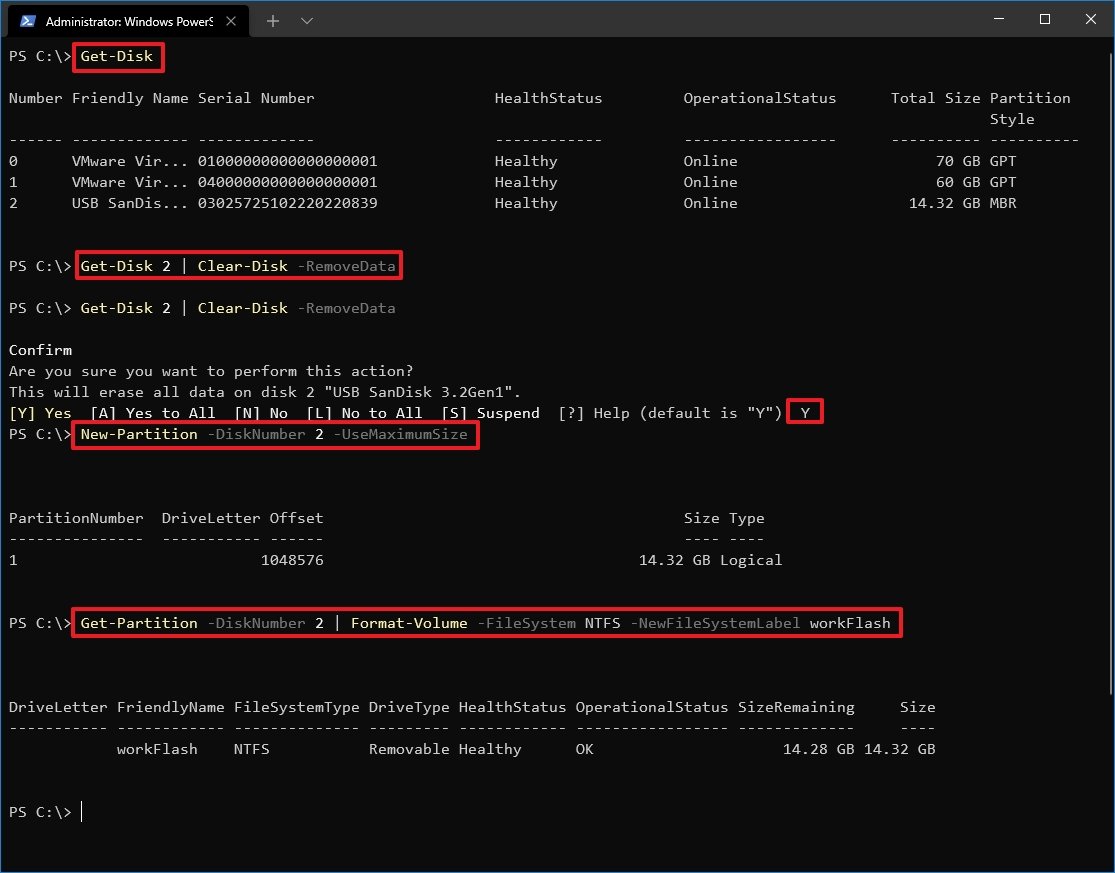 Source: Windows Primal
Source: Windows Primal -
Type the post-obit command to assign a new letter of the alphabet to the bulldoze and press Enter:
Get-Partition -DiskNumber DISK-NUMBER | Set-Partition -NewDriveLetter Bulldoze-Alphabetic characterIn the command, replace DISK-NUMBER for the number that identifies the storage in the system, and DRIVE-Alphabetic character with the letter you desire the device to appear in File Explorer.
This instance sets "East" as the bulldoze letter of the alphabet for disk number 2:
Go-Partition -DiskNumber 2 | Set up-Partition -NewDriveLetter Due east
After yous complete the steps, PowerShell volition remove any information on the removable USB storage to fix problems, including data corruption, write protection, and unrecognized drives. Then information technology will proceed to create a new partitioning and configure a file organisation to store files.
How to format USB flash bulldoze with Command Prompt
Alternatively, you can also format a USB flash drive using commands. Or yous can use the Command Prompt to clean the bulldoze and showtime fresh with a new partition and file organisation table.
Format flash drive using control-line
To perform a quick or full format on a USB wink drive with Command Prompt, utilize these steps:
- Open Get-go.
- Search for Command Prompt, right-click the pinnacle result, and select the Run as ambassador option.
-
Blazon the post-obit command to perform a quick format of the USB flash drive and printing Enter:
format VOLUME: /5:FLASHDRIVE-Characterization /fs:FILE-SYSTEM /qIn the command, make sure to supervene upon the Book with the correct bulldoze alphabetic character of the storage, FLASHDRIVE-LABEL with the proper name you want the drive to appear in File Explorer, FILE-System with one of the bachelor file systems, including "FAT32," "exFAT," or "NTFS."
This example performs a quick format of the East drive:
format Grand: /five:workFlash /fs:NTFS /q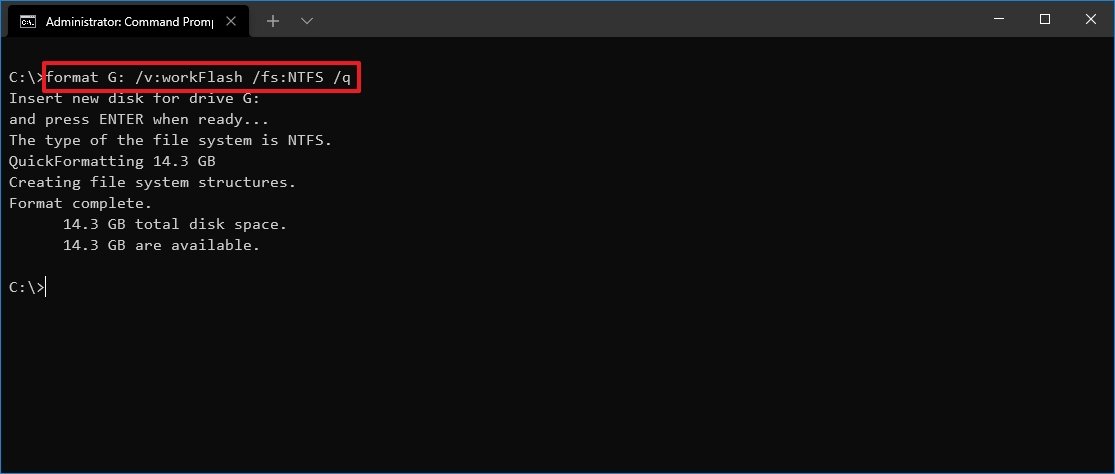 Source: Windows Central
Source: Windows Central - Press Enter once again to continue.
-
(Optional) Blazon the post-obit command to perform a full format of the USB wink drive and printing Enter:
format VOLUME: /five:FLASHDRIVE-LABEL /fs:FILE-OrganizationThis instance performs a total format of the E drive:
format East: /v:"workFlash" /fs:NTFS - Press Enter once again to continue.
After you lot consummate the steps, the pollex drive volition be formatted with the settings yous specified.
Make clean and format flash drive using command-line
To clean and format a flash drive with command-line, use these steps:
- Open Start.
- Search for Command Prompt, correct-click the top effect, and select the Run as ambassador option.
-
Type the following command to launch the diskpart tool and press Enter:
diskpart -
Type the following command to view a list of the available drives and press Enter:
list deejay -
Type the following control to select the wink drive y'all want to delete and press Enter:
select disk Disk-NUMBERIn the command, make sure to supervene upon DISK-NUMBER for the number representing the drive you are trying to format.
This case selects the flash drive listed as disk number 2:
select disk two -
Type the following control to delete all the partitions on the storage and press Enter:
clean -
Blazon the following control to create a chief partition and press Enter:
create partitioning primary -
Type the following command to perform a quick format and printing Enter:
format fs=FILE-SYSTEM label=Drive-Proper noun quickIn the command, make sure to supercede FILE-Organization for your preferred file organisation, including "FAT32," "exFAT," or "NTFS." Besides, replace Drive-Proper name with the name you want to give the device, and if you do non specify the "quick" choice, then a full format will be performed.
This example rapidly formats the removable storage using the NTFS file organisation and applies the "workFlash" name:
format fs=NTFS label=workFlash quick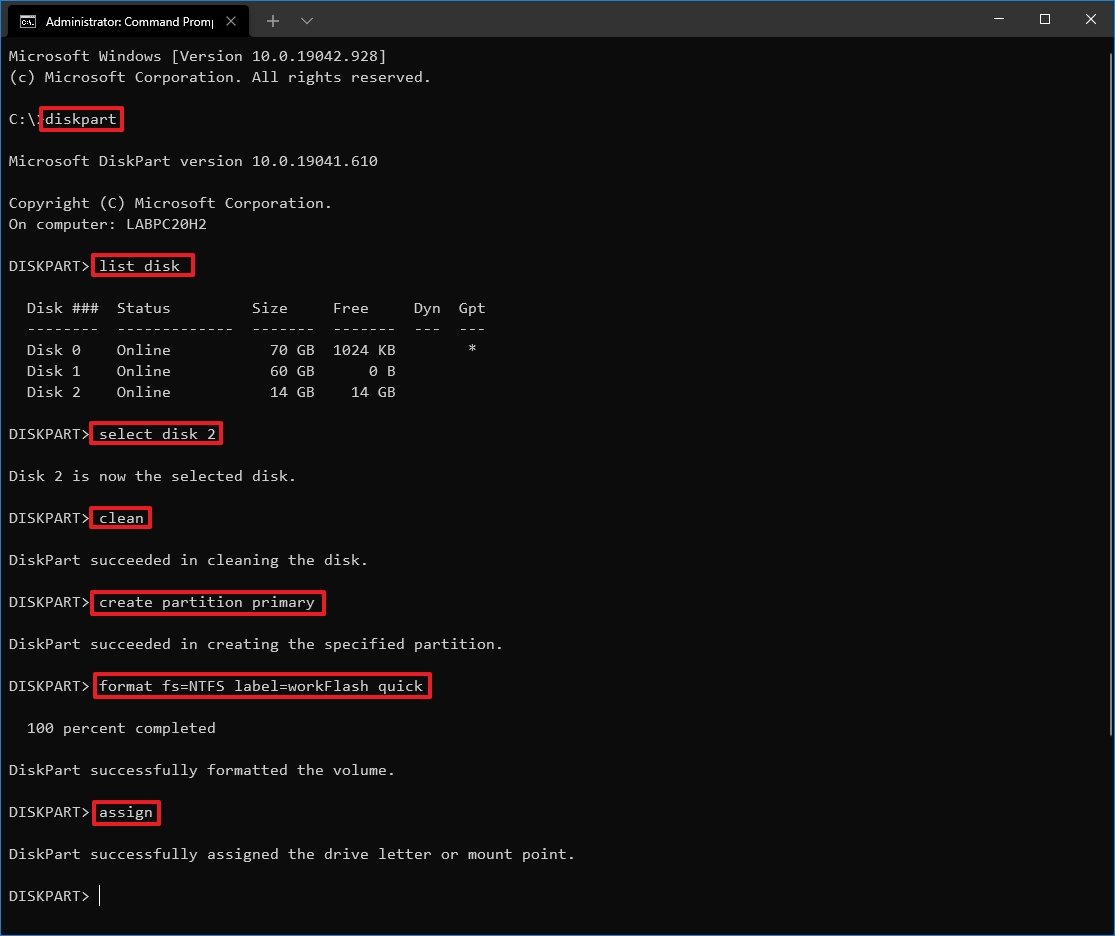 Source: Windows Central
Source: Windows Central -
Type the following command to assign a bulldoze letter and press Enter:
assignQuick note: You can append "letter=E" in the command to assign (in this case) "E" as the drive letter of the alphabet. Otherwise, the organization will assign a letter automatically.
-
Blazon the following control to close diskpart and press Enter:
exit
Once you consummate the steps, the diskpart command-line tool will remove whatsoever information from the USB flash drive. It volition create a new partition and configure a uniform file system to store files from your Windows ten, macOS, or Linux machine (depending on your configuration).
More Windows 10 resource
For more helpful articles, coverage, and answers to common questions well-nigh Windows 10, visit the following resource:
- Windows 10 on Windows Central – All you need to know
- Windows 10 aid, tips, and tricks
- Windows 10 forums on Windows Fundamental
We may earn a commission for purchases using our links. Learn more.

At that place's something for everyone
How to craft the perfect Destiny two build
Destiny 2's sandbox has become both wider and deeper than always before, and as a result, players have the tools to create some very effective builds in both PvE and PvP. Here's an overview of the best ones, besides as a guide on how you lot can start creating your own builds.
Source: https://www.windowscentral.com/how-format-usb-flash-drive-windows-10
Posted by: shipleywatiod.blogspot.com













0 Response to "How To Format A Usb Drive On Windows 10"
Post a Comment